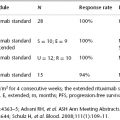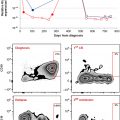Medical Management of Prostate Cancer
Dana-Farber Cancer Institute Boston, MA, USA
Multiple Choice and Discussion Questions
1. A patient has a rising prostate-specific antigen (PSA) level several years after definitive therapy with prostatectomy (or radiation therapy). When is the correct time to start androgen deprivation therapy (ADT)?
There is very little published literature comparing early- versus delayed-initiation of ADT in men with recurrent or advanced prostate cancer. The best evidence in support of early initiation of ADT can be extrapolated from papers by Studer and Moul. Studer (2006) studied 985 patients with newly diagnosed prostate cancer who either refused local definitive treatment or were judged not suitable for it because of decreased life expectancy, advanced local tumor stage, and/or severe comorbidities. Patients were randomized to either immediate ADT or deferred treatment only at the time of symptomatic progression, defined as: new symptomatic metastases or metastases whose location threatened to produce serious complications, such as pathologic fracture or paralysis; increase in pain score; deterioration in World Health Organization (WHO) performance status by two levels due to prostate cancer; and evidence of ureteric obstruction caused by either the primary tumor or metastases. The overall survival hazard ratio was 1.25 (95% confidence interval (CI): 1.05–1.48; noninferiority P > .1), favoring immediate treatment, although this appeared to be due to fewer deaths by causes other than prostate cancer (P = .06). There was no significant difference in prostate cancer mortality or symptom-free survival.
Moul et al. (2008) conducted a retrospective review of clinical outcomes of men with PSA recurrence after prostatectomy, comparing early- versus delayed-use of ADT. Early ADT was associated with delayed clinical metastasis in patients with a pathological Gleason sum greater than 7 or PSA doubling time of 12 months or less (HR = 2.12; P = 0.01). The conclusion of this analysis was that early ADT administered for PSA recurrence after radical prostatectomy was an independent predictor of delayed clinical metastases for high-risk cases only.
In conclusion, there is no level I evidence to guide the timing of ADT in our typical patients with a rising PSA after local therapy. Data from other scenarios as well as retrospective data modestly favor the use of ADT earlier rather than later. However, decision making must be made on an individual basis factoring in the adverse effects associated with long-term ADT as well as patient anxiety from postponing therapy. Use of early ADT is probably overtreatment with associated toxicity for patients with indolent features such as a slowly rising PSA or significant comorbidities.
2. A patient presents with newly diagnosed metastatic prostate cancer. What does appropriate therapy for this patient include?
- Androgen deprivation therapy (ADT) alone
- ADT plus zoledronic acid
- ADT plus denosumab
- ADT with a baseline dual-energy x-ray absorptiometry (DEXA) scan
There is currently no evidence to support the use of an antiresorptive agent at the time of diagnosis of de novo metastatic disease. The single best treatment for androgen-sensitive prostate cancer is ADT. Patients being started on ADT should have a DEXA scan to calculate a WHO Fracture Risk Assessment (FRAX) score to assess the risk of skeletal-related events (SRE). Patients should be started on calcium and vitamin D supplementation. Antiresorptive agents should be considered for men ≥50 with a history of prior hip or vertebral fracture OR osteoporosis (T score: < −2.5) OR osteopenia (T score: −1 to −2.5) AND one of the following: (i) concurrent ADT use (≥6 months), (ii) fracture at site other than hip or spine, (iii) FRAX score showing a 10-year risk of hip fracture ≥3%, or (iv) a 10-year risk of osteoporosis ≥20%.
3. Abiraterone acetate (AA) was recently approved by the US Food and Drug Administration (FDA) as first-line therapy for castration-resistant prostate cancer (CRPC). What is the mechanism of action for this drug?
- Luteinizing hormone receptor agonism
- Luteinizing receptor antagonism
- CYP17A1 inhibition
- Inhibition of androgen receptor signaling
AA is a novel, potent inhibitor of CYP17A1. It decreases production of testosterone by inhibiting CYP17A1, an enzyme that is expressed in testicular, adrenal, and prostatic tumor tissues and needed for androgen biosynthesis. AA was shown to improve overall (OS) and progression-free survival (PFS) after treatment with docetaxel in the COU-AA-301 trial. Patients were randomized 2 : 1 to receive AA versus placebo with 5 mg prednisone twice daily. OS was improved in the AA group (14.8 vs. 10.9 months; HR: 0.65; 95% CI: 0.54–0.77; P < .001). PFS and PSA response rates were also superior in the AA arm. The significant side effects of this medication are due to mineralocorticoid excess (hypertension, edema–fluid retention, and hypokalemia). This study led to the approval of the drug as second-line therapy after docetaxel. The more recent COU-AA-302 study compared AA plus prednisone with prednisone alone in patients with progressive metastatic CRPC who had not received chemotherapy and in whom clinically significant cancer-related symptoms had not developed. The study was unblinded at the interim analysis. Patients on the AA arm demonstrated improved radiographic PFS, and they showed a trend toward improved OS and delayed time to initiation of cytotoxic chemotherapy, opiate use for cancer-related pain, PSA progression, and decline in performance status. This study led to the recent FDA approval of AA as first-line therapy for metastatic CRPC.
4. Are there any new chemotherapeutics beyond docetaxel?
Cabazitaxel is a novel taxane with activity in the preclinical models of cancer resistant to paclitaxel and docetaxel that has demonstrated improved OS when compared with mitoxantrone in the post-docetaxel setting in the TROPIC trial. In this trial, patients received 10 mg of prednisone daily and were randomized to 12 mg/m2 mitoxantrone or 25 mg/m2 cabazitaxel every 3 weeks. Overall survival was 15.1 months in the cabazitaxel group versus 12.7 months in the mitoxantrone group (HR: 0.70; 95% CI: 0.59–0.83; P < .0001), response rate was 11.4% versus 4.4% (P = .0005), and progression-free survival was 2.8 versus 1.4 months (P < .0001), respectively.
At the dose administered, cabazitaxel was associated with increased toxicity compared with mitoxantrone. The most significant toxicities seen were grade 3 or greater neutropenia (82%), neutropenic fever (8%), and diarrhea (6%). 12% required dose reductions and 18% required discontinuation of therapy because of these adverse events. Careful monitoring is recommended when administering this agent with a low threshold for dose reduction and for use of growth factor support with granulocyte colony-stimulating factor.
The FIRSTANA trial is currently comparing the efficacy of cabazitaxel to docetaxel as first-line therapy. Patients receive 10 mg prednisone daily with docetaxel at 75 mg/m2, cabazitaxel at 25 mg/m2, or cabazitaxel at a lower dose of 20 mg/m2 every 3 weeks with the primary endpoint of OS.
5. Enzalutamide is not recommended for the treatment CRPC in patients with which of the following conditions?
- Renal insufficiency
- Seizures
- Cardiovascular disease
- Diabetes
- All of the above
Enzalutamide is a potent inhibitor of the androgen receptor that prevents androgen binding to the androgen receptor and androgen receptor translocation into the nucleus. It was approved by the FDA in 2012 for the treatment of patients with metastatic CRPC who have previously been treated with docetaxel.
In the phase III AFFIRM study, patients with metastatic CRPC previously treated with docetaxel were randomized 2 : 1 to receive enzalutamide 160 mg/day versus placebo. OS in the enzalutamide arm was 18.4 months versus 13.6 in the placebo arm. However, it was notable that 7 of 800 patients treated with enzalutamide experienced a seizure versus none in the control group. Consequently, this medication is not recommended for patients with predisposing factors for seizure such as a history of seizure or cerebral vascular accident, a recent transient ischemic attack, brain metastases, or concomitant use of other medication that lowers the seizure threshold.
6. What is the role of sipuleucel-T in the treatment of CRPC?
Sipuleucel-T was the first immunotherapy to demonstrate an OS benefit in the treatment of metastatic CRPC. This agent is produced by isolating autologous peripheral blood mononuclear cells, including antigen-presenting cell, through leukopheresis and then culturing them with medium that contains the recombinant fusion protein PA2024, consisting of prostatic acid phosphatase fused to granulocyte-macrophage colony-stimulating factor.
This therapy was evaluated in the IMPACT study wherein asymptomatic or minimally symptomatic patients with metastatic CRPC were randomized 2 : 1 to receive three infusions of sipuleucel-T versus placebo. Overall survival was 25.8 months in the sipuleucel-T arm versus 21.7 months in the placebo arm, and the relative risk of death was 22% lower in the sipuleucel-T group versus placebo (HR: 0.78; 95% CI: 0.61–0.98; P = .03). Of note, there was no difference in PSA response rate or PFS associated with this therapy. Interestingly and not surprisingly, Kaplan–Meier survival curves for sipuleucel-T versus placebo diverge after 6 months of treatment. Understanding the mechanisms of OS benefit without improving PFS and identifying who is likely to benefit from therapy remain unclear. The treatment is generally well-tolerated, and it was approved by the FDA for asymptomatic or minimally symptomatic patients with metastatic CRPC who are chemotherapy-naïve or who have received prior chemotherapy. The adoption of this drug into practice was initially slow because of a lack of immediate benefit and cost. Use of this agent has increased over the past year. It is reasonable to consider using sipuleucel-T, particularly in asymptomatic or minimally symptomatic patients or in patients with low PSAs. It should not be used in patients with poor performance status or with rapidly progressive or symptomatic disease.
7. When starting a patient on ADT for rising PSA after definitive therapy, should one start a single agent or use combined androgen blockade for more potent therapy?
Medical or surgical castration is the treatment of prostate cancer that has recurred following definitive therapy with radiation or surgery or de novo metastatic disease. There are several types of agents that can be used to achieve medical castration, including luteinizing hormone–releasing hormone (LHRH) agonists and LHRH antagonists. LHRH agonists stimulate the LHRH receptors, causing an initial testosterone flare. Antiandrogens are typically co-administered with LHRH agonists to mitigate these symptoms. In 2008, Degarelix was the first LHRH antagonist approved by the FDA for the treatment of advanced prostate cancer. LHRH agonists and antagonists are equally effective in achieving medical castration. The advantage of degarelix is that it achieves castration levels of testosterone within 3 days without necessitating the use of a concomitant antiandrogen.
Combined androgen blockade (CAB) is continuous therapy with an LHRH agonist and an antiandrogen. Although randomized trials have not consistently demonstrated a survival benefit to CAB, systematic review and meta-analysis of monotherapy compared with CAB showed a modest increase in overall survival at 5 years for CAB (10 trials; HR: 0.871; 95% CI: 0.805–0.942). For the subgroup of patients with good prognosis, there was no statistically significant difference in survival. Adverse events were more common in the CAB population.
The decision to treat with CAB must balance the risks of adverse effects and the potential for affecting quality of life with a modest survival benefit. Although CAB may be more potent than single-agent therapy, the benefits are probably modest. This area will likely be redefined with the newer androgen-blocking agents such as abiraterone and enzalutamide; however, they are not yet approved for this indication.
8. Is intermittent ADT safe in locally advanced or metastatic prostate cancer?







